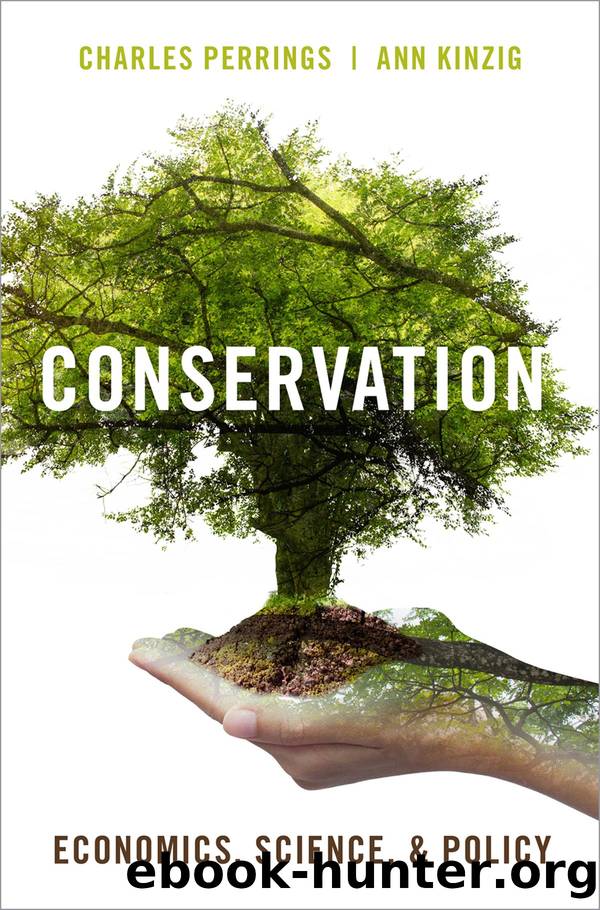Conservation: Economics, Science, and Policy by Charles Perrings & Ann Kinzig

Author:Charles Perrings & Ann Kinzig [Perrings, Charles & Kinzig, Ann]
Language: eng
Format: epub
Tags: Business & Economics, Environmental Economics, nature, Natural Resources, Technology & Engineering, Power Resources, Alternative & Renewable
ISBN: 9780190613600
Google: dsMoEAAAQBAJ
Publisher: Oxford University Press
Published: 2021-06-15T00:30:54.197551+00:00
Figure 9.7 The efficiency of property-rights based solutions to externalities.
Showing that the efficiency of the solution does not depend on who receives the rights.
The first instrument for solving such problems was proposed in a rightly famous paper published in 1960 by Ronald Coase. Coase observed that the then-standard approach to the management of environmental externalities asked: If one person inflicts harm on another, how can that person be restrained? He argued that this is the wrong
question, since all externalities are essentially reciprocal. In our example, while the downstream community may be harmed by the activities of the upstream community, the upstream community would also be harmed by any restriction on its activities. The question should really be whether the upstream community should be allowed to inflict harm on the downstream community, or the downstream community should be allowed to inflict harm on the upstream community. He argued that the aim should be to avoid the more serious harm (Coase 1960).
The Coase theorem states that if there are well-defined property rights in some environmental effect, if there are no transaction costs, and if wealth effects are negligible, then the outcome of bargaining between the interested parties will be Pareto optimal regardless of the distribution of those rights. Translated, it means that in certain circumstances it is possible to internalize external effects by assigning rights to the effect, and that the outcome will be efficient regardless of who receives the rights (Figure 9.7).
The various conditions attached to the proposition imply that if transaction costs are too high to motivate the establishment of a market, it may be optimal not to internalize the external effect. Similarly, if the assignment of property rights makes some people much wealthier or poorer than they were before, it may also be better to not to assign rights. Since the allocation of rights always increases the wealth of the rights-holder (just as the assignment of liability always reduces the wealth of those held to be liable), the decision to allocate rights one way or the other is generally made on political grounds. Perceptions of fairness tend to favor both the first-in-time principle and the polluter-pays principle. Rights go to those who were there first (grandfathering) and against those whose actions are the source of the externality.
A second set of instruments, economic incentives, comprises Pigovian taxes, user charges or fees, and subsidies and payments for ecosystem services. Taxes, charges, and fees are intended to confront those who are the source of negative externalities with the costs they impose on others. They have their origin in work by the economist Arthur Pigou, who proposed taxing/subsidizing private activities that were excessive/insufficient from a social perspective (Pigou 1912, Pigou 1920). In Figure 9.8, taxes equal to the marginal external cost caused by the harmful input reduce employment of that input from the privately optimal level to the socially optimal level . Moreover, this is independent of the form of the taxâwhether it is a flat or variable rate. Examples include taxes on
Download
This site does not store any files on its server. We only index and link to content provided by other sites. Please contact the content providers to delete copyright contents if any and email us, we'll remove relevant links or contents immediately.
Zero to IPO: Over $1 Trillion of Actionable Advice from the World's Most Successful Entrepreneurs by Frederic Kerrest(4296)
Machine Learning at Scale with H2O by Gregory Keys | David Whiting(4183)
Never by Ken Follett(3793)
Harry Potter and the Goblet Of Fire by J.K. Rowling(3775)
Ogilvy on Advertising by David Ogilvy(3511)
Shadow of Night by Deborah Harkness(3303)
The Man Who Died Twice by Richard Osman(2997)
Book of Life by Deborah Harkness(2867)
The Tipping Point by Malcolm Gladwell(2827)
Will by Will Smith(2793)
0041152001443424520 .pdf by Unknown(2784)
My Brilliant Friend by Elena Ferrante(2774)
How Proust Can Change Your Life by Alain De Botton(2742)
Purple Hibiscus by Chimamanda Ngozi Adichie(2652)
How to Pay Zero Taxes, 2018 by Jeff A. Schnepper(2602)
Hooked: A Dark, Contemporary Romance (Never After Series) by Emily McIntire(2502)
Rationality by Steven Pinker(2291)
Borders by unknow(2229)
Can't Hurt Me: Master Your Mind and Defy the Odds - Clean Edition by David Goggins(2228)
